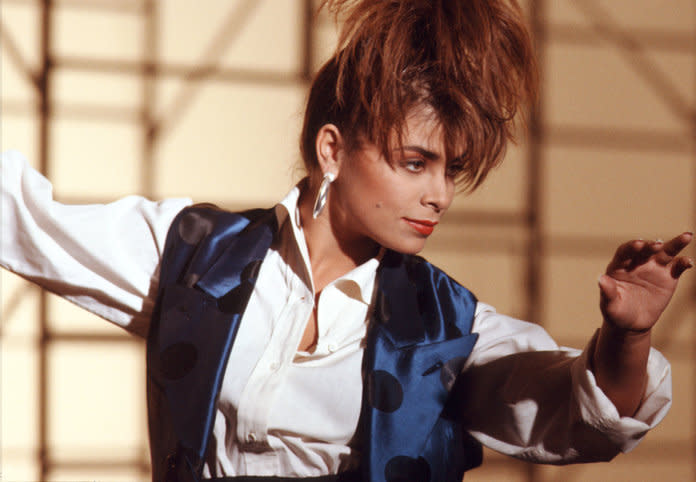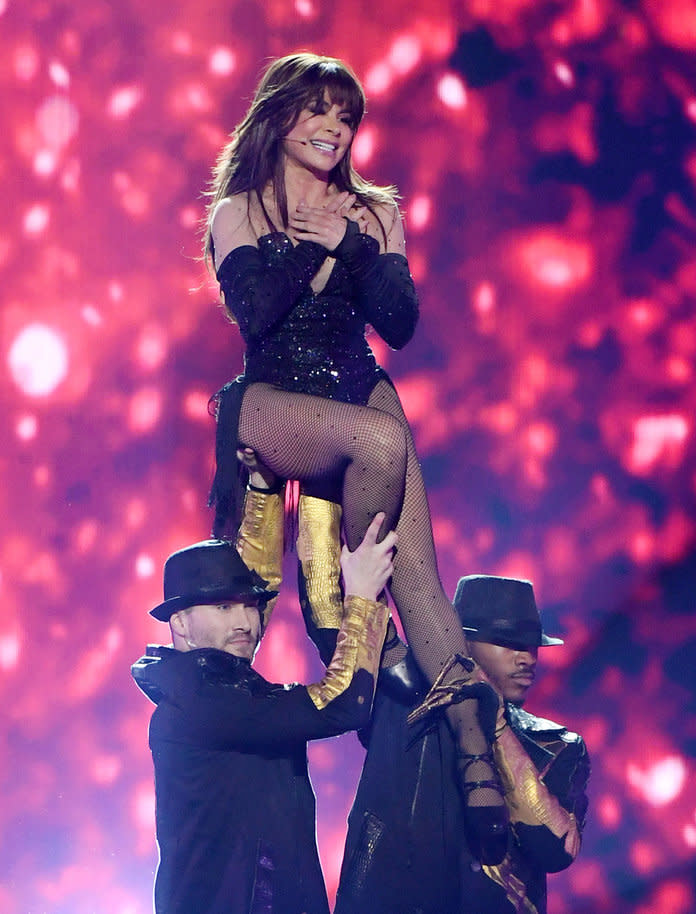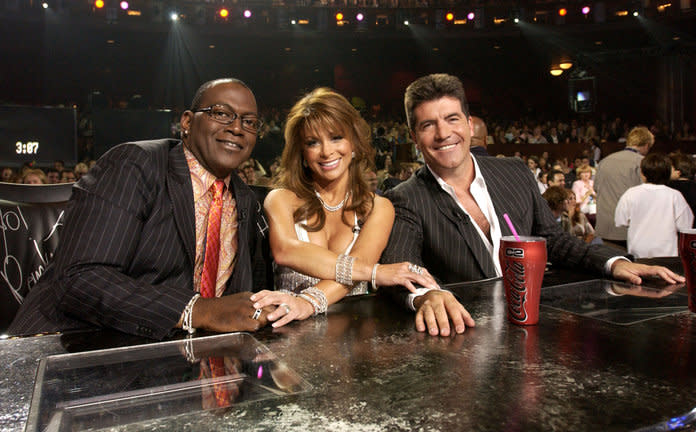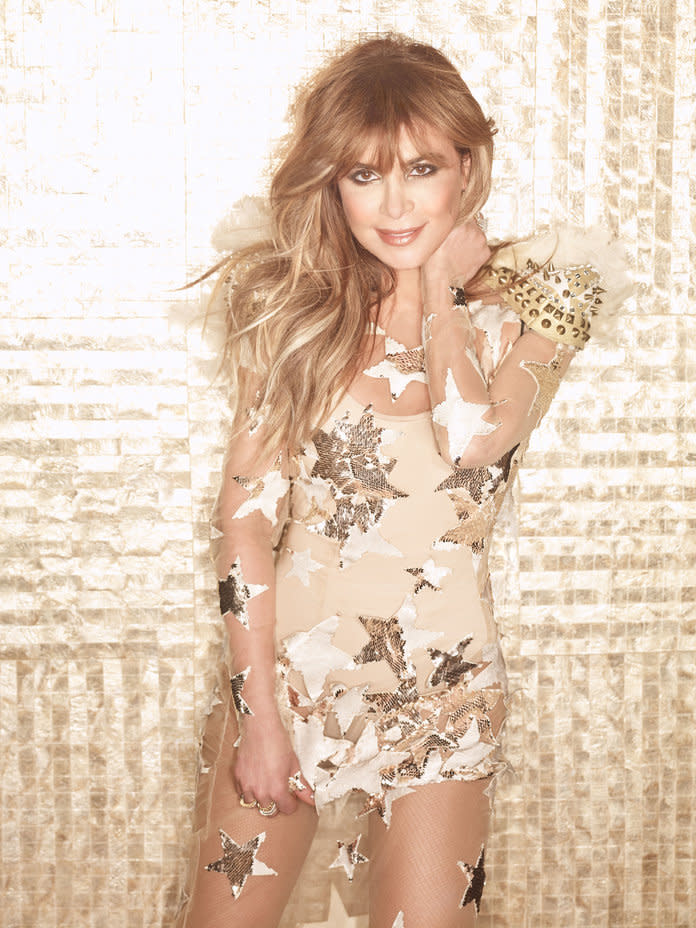Paula Abdul Isn't Making a Comeback — She's Having a Renaissance
On the hottest Saturday in July, I stood on a chair in a sweaty ballroom at Manhattan’s Grand Hyatt Hotel, right next to a row of giddy dance moms filming their children. But when I leaned in closer, I saw their cameras were actually trained on the stage, where ’90s pop icon Paula Abdul was teaching 200 kids and teens the choreography to her 1988 hit single, “The Way That You Love Me.”
“Which one’s yours?” I whispered to the woman next to me. “There,” she said, pointing to a girl no older than 13 wearing strategically ripped leggings and a purple crop top.
“Does she know who Paula is, really?” I asked.
“Ehhh,” she said, gesturing so-so. “The kids know she’s famous. But from American Idol. In Dallas, though, I heard a mom rushed the stage, sobbing. They had to escort her out.”
I get it. As an early ’90s tween, I worshipped at the altar of Abdul. All of my friends were team Madonna, but I was a young dancer who dreamt in “5-6-7-8.” I committed Abdul’s every move to memory, tracked down every flimsy biography I could find, and dressed as her for not one, but three Halloweens in a row. I convinced myself that with my olive skin; long, dark brown hair; beauty mark; and California provenance, that maybe, just maybe, I could be Paula Abdul.
RELATED: Fran Drescher on Making "Sense Out of the Senseless"
I asked the violinist to recreate Paula Abdul's "RUSH RUSH" at the end of Grand Piano. That part always made me cry. #ThePinkprintTakeover
— MEGATRON (@NICKIMINAJ) December 19, 2014
And that day in the Grand Hyatt ballroom, decades after the first Paula Abdul poster went up on my wall, I got to talk to her about all of it.
“I believe there's genius in every human being,” Abdul tells me. “You have dancers with impeccable technique who've trained professionally for years who can perform the most complicated turns and combinations like it's nothing. But there are equally talented dancers with no professional training who turn, kick, leap, and create their own style and choreography on a neighborhood street.”
As both performer and mentor, Abdul continues to inspire Hollywood’s up and coming. When performers reflect on her influence, it’s often with visceral language. “If you're any kind of dancer, this one should be in your bones,” chides Naya Rivera’s character on a 2013 episode of Glee before breaking into a rendition of “Cold Hearted.”
RELATED: Debra Messing Gets Honest
Actress and dancer Jenna Dewan, who ushered in the mid-aughts dance-movie craze as the star of Step Up, says Abdul sparked her creative genesis. “The first time I saw Paula dance, I was utterly captivated,” Dewan says. “She was and is one of my biggest influences as a performer.” Drag Race alum Sonique says Abdul kick-started her passion for performance. “Drag performers are inspired by strong female energy. You know when you hear a Paula song come on at the show, the performer is going to let you have it.”

Getty Images
2019 marks 30 years since Abdul’s debut album made history. Forever Your Girl was the first debut by a woman to produce four number-one singles on the US Billboard charts, a feat matched since only by Mariah Carey. And this August, with her first Las Vegas residency, Abdul will bring those beloved song-and-dance numbers back to the stage.
Billed as a multimedia experience, Paula Abdul: Forever Your Girl at The Flamingo will include performances of all Abdul’s classics, as well as BTS reveals from her time on American Idol. When I ask how she feels about calling this a “comeback,” she replies calmly: “Resurgence, reinvention. However people want to describe it is fine!”
Maybe she’s that easy-going — or maybe, she’s simply employing the girl-next-door approachability that got her tagged as the “nice one” on Idol. “During the height of Idol, when the whole culture was focused on critique, I was made fun of for being kind. But kindness is not a weakness. If I was weak, I wouldn’t have lasted 30 years in this business.”
Abdul was born to Jewish parents — a Syrian father who was raised in Brazil and a Canadian mother who worked as Hollywood director Billy Wilder’s assistant. She idolized MGM studio-era visionaries like Gene Kelly and Bob Fosse, dancers whose work would later infuse her style. By age five, she was gathering neighborhood kids in the courtyard of her North Hollywood condo building to direct them in dance numbers. By age eight, she began training in tap, ballet, and jazz with Joe Tremaine, a choreographer who’s worked with A-list celebs such as Cameron Diaz, Selma Blair, Cher, and Diana Ross. At 18, Abdul joined the Laker Girls. She was quickly promoted to choreographer and transformed the squad from pom pom-wielding eye candy to legitimate dance team.
“Paula really shattered the idea that a dancer could only dance. You could be an all-around entertainer,” says Tremaine. “When she started cheerleading, I told her it was going to ruin her technique. Instead, she became Paula Abdul!”

Her signature style on the court — a mix of jazz and street — caught the eye of the Jackson brothers, who hired her to choreograph their 1984 “Torture” video and later introduced her to one of the most important collaborators of her early career: Janet Jackson. Abdul choreographed Jackson’s most iconic early videos, including "Nasty,” “Control,” and “What Have You Done for Me Lately.” By the mid-‘80s, she was working across film, music, and TV; choreographing the epic wedding scene in Coming to America one day and musical numbers at the Academy Awards the next.
But Abdul wanted more. Between gigs, she quietly began recording songs of her own and was one of the first artists signed to a then-fledgling Virgin America label in 1987. After her first two singles met lackluster response, radio stations started playing “Straight Up” in 1988.
It was the song that changed everything.
“Straight Up,” which Abdul famously retrieved from the trash after her mother tossed the songwriter’s demo, calling it ‘so bad’ that she was ‘crying laughing’ at it, skyrocketed overnight.
Within weeks, Abdul had sold a million copies and helped establish Virgin America as a legitimate label. Forever Your Girl ultimately spent 64 weeks on the charts, but with an entire year between its release and peak, it was also the longest an album had ever been on the market before climbing to the top. This lag was a strange foreshadowing of the next three decades in which Abdul would remain both two steps ahead and a minute behind the zeitgeist.
Pre-MTV, dancers’ avenues for professionalization were few: join a company, bust ass on Broadway, or teach classes. To be the star attraction, a dancer also had to be a singer or an actor. With the dawn of MTV and the music video, suddenly dancers could take center stage. “That time was special,” says Abdul, reflecting on MTV’s genesis and the video culture of the ’90s. “Big artists were having their world premieres and we’d all know and tune in to see them. Videos were an open canvas for me to create anything I wanted.”

While video culture today relies on virality (the digital equivalent of word of mouth) and secret midnight drops, visual albums like Beyoncé’s reinforce the continued cultural relevance of image alongside music. This was something Abdul understood, and early in her career she used visual storytelling as a way to enhance her music.
Many of her early videos were like mini-musicals, tributes to the type of classic Hollywood films where problems seemed easily solved with cheeky plot twists or rousing musical numbers. “Rush, Rush,” was a soft romantic spin on the Mercury Coupes and poodle skirts of Rebel Without a Cause; “Cold-Hearted” was a sexed-up recreation of a scene from Fosse’s All That Jazz; and “Opposites Attract,” the Grammy-winning video where Abdul danced alongside a cartoon cat named MC Skat Kat, was a nod to Gene Kelly’s Anchors Aweigh, in which Kelly, playing a sailor, teaches cartoon mouse Jerry (of Tom and Jerry) how to tap dance. The video earned Abdul weekly tea dates with Kelly for years.
“I don’t like following suit,” she says. “I’ve always been a little bit ahead of the times. What in my mind seems very commercial can seem uncommercial to the industry. But within the next five to 10 years that idea will be very popular.”
RELATED: Inside the Coachella of the Beauty World
As writer Pier Dominguez pointed out in an astute comparison of American pop idols Britney Spears and Abdul, Abdul became a judge on Idol long before mega-stars like Gwen Stefani and Alicia Keys joined reality competition TV. Her work on Idol not only paved the way, but also spawned dozens of copycat shows worldwide. And now, with Spears on indefinite hiatus, Abdul is cementing her place alongside power players like Lady Gaga and Celine Dion in the renaissance of the Las Vegas residency.
Even her casting of everyone’s feminist crush du jour, Keanu Reeves (then best known as “a totally rad dude)” in the 1991 video for “Rush, Rush” was prescient. “I hired him right after he did Bill & Ted’s Excellent Adventure. I just felt there was something really special about him."
“I’m a people watcher,” she says. “I watch what others are doing in the industry and if there’s a visceral feeling there, even something intangible, I try to explore it. In my career, I’ve had to spend time and money fleshing out an idea because for me to try and explain it without them physically seeing it would be too difficult. Sometimes you have to believe in yourself that much.”
At the beginning of her career, Abdul was afraid to slow down. "I thought I wouldn't have enough time, or that I'd miss a big opportunity and I'd never get that opportunity again. I didn't want to stop the momentum. Looking back, I can see now that everything happened in perfect timing.”

That’s not to say that the ride has been easy — Abdul has pushed through some legitimately dark times. By 36, she was twice-divorced. Early on she struggled with bulimia and accusations of vocal mixing. After a long history of chronic pain due to, among other things, a jet crash-landing during her 1992 "Spellbound" tour (a story that has raised eyebrows), Abdul was unable to perform.
During the Idol era, she was accused of substance abuse and having an affair with Idol contestant Corey Clark (whose claims were thrown out). A stalker who renamed herself Paula Goodspeed died in a car parked outside of her house. Initially, she’d envisioned Idol as a way to work through the pain and mentor young artists in the meantime. Instead, her condition worsened when she developed RSD, an excruciating nerve disorder. The symptoms of her struggle were on display for a primetime audience, but as a performer she felt pressure to stay silent.
“When you’re in the industry, you don’t want to let people see you sweat," Abdul says. People don’t wear pain, really. So I think it’s pretty brave for people to work through it and give their all while performing.”
Thankfully, she won’t have to white knuckle her way through Vegas. “I don’t experience the type of physical pain that I used to,” she says, attributing her improvement to a non-invasive treatment called Cortical Integrative Therapy. “Once I really accepted that for a time, pain was part of my life, I was able to move forward. I didn’t have to like the pain, but to accept that it was there. Fighting it made it worse for me. I keep getting the message that I have to slow down. Slowing down has made so many of my dreams come true. My career is in a whole renaissance.”
After the Grand Hyatt class, we chat for a few minutes about the details of her residency, which has a soft opening from August 13 to 17, then comes back for select dates in October, November, December, and January. Tickets for "Forever Your Girl" start at $69.

“I’ve never put something like this together in such a short amount of time.” She looks a little nervous — she’s pulling together a blockbuster show in less than a month — but mostly she looks alive at the thought. “It’ll be a work in progress!”
As she talks, I flash back to her stats from my dog-eared girlhood copy of The Magic of Paula Abdul: From Straight Up to Spellbound — the first time I learned she's just five feet tall. As I reach my hand out to shake hers, she pulls me in for a hug and through my star-studded haze I notice through the image on her T-shirt is a face with two sides: half her own, half MC Skat Kat. Opposites who attract. Twins. I remember the one thing I told myself not to forget when interviewing Abdul. She’s a Gemini. The twins of the zodiac, Geminis are not necessarily two-faced, as they’re often perceived, but they do embody duality. Famously charismatic, Geminis reveal themselves with such strategy and panache that they’ve already left the room by the time you realize how little they’ve actually revealed.
At once warm and vulnerable, Abdul has a charismatic sheen you cannot pierce. Perhaps that duality is what’s so captivating about her. What ushered her into the spotlight as America’s sweetheart 30 years ago and has kept us wondering what’s going on behind the scenes ever since. She opts out of my follow-up questions about wild ‘90s parties and while she happily answers the rest, she avoids anything too revelatory or incendiary.
“There's so much for a caterpillar to do to prepare itself before it turns into a butterfly,” Abdul says. "It's not an all-of-a-sudden transformation. There's a point when it wraps itself in a cocoon so it can change. Each area of my career — dance performance, choreography, singing, acting, mentoring — had an awkward, unflattering 'before' phase," she says. “Even with the challenges and uncomfortable moments, I've made it through to that flying ‘butterfly’ phase time and time again.”

 money
money 